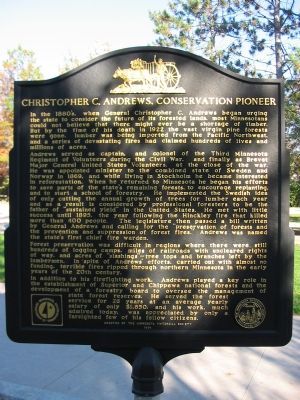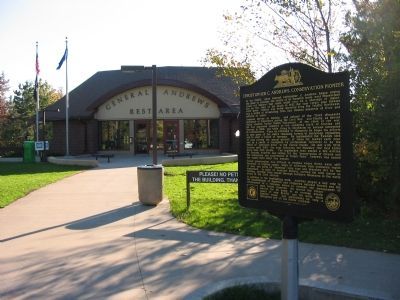Near Willow River in Pine County, Minnesota — The American Midwest (Upper Plains)
Christopher C. Andrews, Conservation Pioneer
Andrews served as captain, and colonel of the Third Minnesota Regiment of Volunteers during the Civil War, and finally as Brevet Major General United States Volunteers, at the close of the war. He was appointed minister to the combined state of Sweden and Norway in 1869, and while living in Stockholm he became interested in reforestation. When he returned to Minnesota he began his efforts to save parts of the state's remaining forests, to encourage replanting, and to start a school of forestry. He implanted the Swedish idea of only cutting the annual growth of trees for lumber each year and as a result is considered by professional foresters to be the father of "sustained yield" in the United States. He met with little success until 1895, the year following the Hinckley fire that killed more than 400 people. The legislature then passed a bill written by General Andrews and calling for the "preservation of forests and the prevention and suppression of forest fires." Andrews was named the state's first chief fire warden.
Forest preservation was difficult in regions where there were still hundreds of logging camps, miles of railroads with uncleared rights of way, and acres of "slashings" -- tree tops and branches left by the lumbermen. In spite of Andrews efforts, carried out with almost no funding, terrible fires ripped through northern Minnesota in the early years of the 20th century.
In addition to his firefighting work, Andrews played a key role in the establishment of Superior and Chippewa national forests and the development of a forestry board to oversee the management of state forest reserves. He served the forest service for 26 years at an average yearly salary of only $1,650, and his work, much admired today, was appreciated by only a farsighted few of his fellow citizens.
Erected 1991 by the Minnesota Historical Society.
Topics and series. This historical marker is listed in these topic lists: Charity & Public Work • Disasters • Horticulture & Forestry • War, US Civil. In addition, it is included in the Minnesota Historical Society series list. A significant historical year for this entry is 1922.
Location. 46° 21.424′ N, 92° 48.366′ W. Marker is near Willow River, Minnesota, in Pine County. Marker can be reached from Interstate 35 at milepost 208,, 1˝ miles south of Laketown Road (County Road 46), on the right when traveling south. Marker is at the southbound General Andrews Rest Area, 2 miles northeast of Willow River. Touch for map. Marker is in this post office area: Willow River MN 55795, United States of America. Touch for directions.
Other nearby markers. At least 8 other markers are within 14 miles of this marker, measured as the crow flies. Geology of Minnesota (approx. 6˝ miles away); Site of Mass Grave (approx. 7.6 miles away); The 1918 Fire (approx. 9.6 miles away); Lumbering in Minnesota (approx. 10.2 miles away); 1872 (approx. 13.3 miles away); A Railroad Industry (approx. 13.7 miles away); Crushing Stone (approx. 13.7 miles away); Power (approx. 13.8 miles away).
Credits. This page was last revised on November 23, 2019. It was originally submitted on February 10, 2008, by Keith L of Wisconsin Rapids, Wisconsin. This page has been viewed 2,346 times since then and 23 times this year. Photos: 1, 2. submitted on February 10, 2008, by Keith L of Wisconsin Rapids, Wisconsin. • Craig Swain was the editor who published this page.

